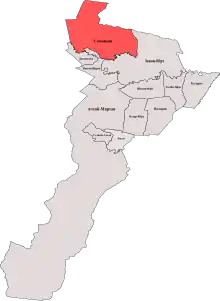Samashki
Samashki (Russian: Самашки; Chechen: СемаӀашка[1]) is a rural locality (a selo) in Achkhoy-Martanovsky District, Chechnya.
Administrative and municipal status
Municipally, Samashki is incorporated as Samashkinskoye rural settlement. It is the administrative center of the municipality and is the only settlement included in it.[2]
Geography

Samashki is located on the left bank of the Sunzha River. It is 9 kilometres (5.6 mi) north of the town of Achkhoy-Martan and 30 kilometres (19 mi) west of the city of Grozny.
From the north, the hills of the Sunzhensky ridge reach the village, and from the south, the Samashki Forestry and the Sunzha River.
The nearest settlements to Samashki are Raduzhnoye in the north-east, Zakan-Yurt in the east, Novy Sharoy in the south, Davydenko in the south-west, and Sernovodskoye in the west.[3]
Name
The name of the village comes from the Chechen: Саь-Маӏашка, which translates roughly as "the place of deers".
History
Samashki was founded in 1851,[4] as a part of the Sunzhensky Cossack line, on the site of the destroyed Chechen village of Lower Samashki.[5] Later, on Order number 01721, the entire Cossack population of the village was evicted.[6] The village was then given back to the Chechens, who repopulated it.
In 1944, after the genocide and deportation of the Chechen and Ingush people and the Chechen-Ingush ASSR was abolished, the village of Samashki was renamed and settled by people from other ethnic groups.[7] From 1944 to 1957, it was a part of the Novoselsky District of Grozny Oblast.
In 1958, after the Vaynakh people returned and the Chechen-Ingush ASSR was restored, the village regained its old name, Samashka.[8]
Samashki in the Chechen Wars
During both Chechen Wars the village suffered greatly from the hostilities,[9] most notably in the notorious April 1995 incident known as Samashki massacre which resulted in the deaths of more than 100 to 300 civilians.
In March 1996 another attack on the town took the form of a full-scale assault with apparent disregard for the civilian lives; according to Human Rights Watch, Russian forces used civilians as a human shields on APCs.[10] Reports suggested some 500 civilians were killed altogether in the result of the April 1995 and March 1996 attacks.[11] The next month, Russian journalist Nadezhda Chaikova, who had filmed the effects of the 1996 attack, was killed execution-style in Chechnya.[12]
A devastating artillery and rocket attack on Samashki took place in October 1999 at the beginning of the Second Chechen War, despite the demilitarization of the village,[13] killing or injuring dozens of residents on the day of October 27, 1999 alone, according to HRW.[14] At the time, the deputy commander of the North Caucasus Military District announced that there were only "bandits and terrorists" in Samashki,[11] but a report for the British parliament claimed civilians were killed in revenge for the heavy casualties suffered there by Russian forces during the first war.[15]
Federal forces reported a large-scale operation in Samashki in May 2000.[16]
Population
- 1979 Census: 9,185
- 1990 Census: 9,945[17]
- 2002 Census: 10,824[18]
- 2010 Census: 11,275[19]
- 2019 estimate: 12,597
According to the results of the 2010 Census, the majority of residents of Samashki (11,263 or 99.9%) were ethnic Chechens, with 12 people (0.1%) coming from other ethnic backgrounds.
Teips
Members of the following teips (clans) live in Samashki:
- Nashkhoy,
- Zandak,
- Sharoy,
- Zumsoy,
- Terloy,
- Nuokhoy,
- Galay,
- Akkiy,
- Keloy,
- Cheberloy,
- Dai
- Nizhloy,
- Gukhoy,
- Kesaloy,
- Khimoy,
- Khakmadoy,
- Shikaroy,
- Chanti,
- Buosoy.
Famous natives
- Lyoma Satuyev, Honored Artist of the Chechen Republic, theater and film actor;
- Usman Dadayev, tightrope walker, People's Artist of the Chechen Republic, Honored Artist of the Republic of Ingushetia;
- Mikhail Ivanyukov, Hero of Socialist Labor;
- Prokofi Kalashnikov, Hero of the Soviet Union, colonel, tanker;
- Shumisat Khazhmukhambetova, sambo wrestler and judoka, champion of the USSR, silver medalist of the Spartakiad of the peoples of the USSR, master of sports of the USSR in sambo and judo.
Transportation
The R217 federal highway "Caucasus" passes 4 kilometres (2.5 mi) south of the village. Also, a railway line from Nazran to Grozny passes through the village. Part of the village is located beyond the railway.
References
- "Ярташ". "Даймохк" газет (in Russian).
- "Сельское поселение Самашкинское (Чеченская Республика)". www.bankgorodov.com.
- "Карта Чеченской республики подробная с районами, селами и городами. Схема и спутник онлайн". 1maps.ru.
- "Основные сведения о Терской области. ч.3" (PDF).
- "Кавказский календарь... на 1860" (in Russian). 1859.
- "ПРИКАЗ № 01721 оп - ЛЕТКА". xn--80ajpc0b.xn--p1ai.
- "Потери вооруженных сил России и СССР в вооруженных конфликтах на Северном Кавказе (1920–2000 годы)". www.demoscope.ru.
- "О восстановлении Чечено-Ингушской АССР и упразднении Грозненской области". lawru.info (in Russian).
- Chechen villagers ask, why us?, The Guardian, November 17, 1999
- ACCOUNTABILITY By the Russian Side, Human Rights Watch, 1997
- Russian bombardment sows terror in town, Boston Globe, 13 November 1999
- Journalists Killed in 1996: 26 Confirmed, Committee to Protect Journalists, December 31, 1996
- How war came to a Chechen village, BBC News, 1 December 1999
- Many Civilians Killed in Samashki Village, Chechnya, Human Rights Watch, November 4, 1999
- The Conflict in Chechnya, Parliament of the United Kingdom, 2000
- Top Russians killed in Chechnya, BBC News, 31 May 2000
- "Наши издания - Архивное управление Правительства Чеченской Республики". arhiv-chr.ru.
- Kashnitsky, Ilya (11 April 2017). "Municipality level Russian Census data 2002 and 2010". doi:10.17605/OSF.IO/CSKMU.
- "ВПН-2010". www.gks.ru.
External links
 Media related to Samashki at Wikimedia Commons
Media related to Samashki at Wikimedia Commons